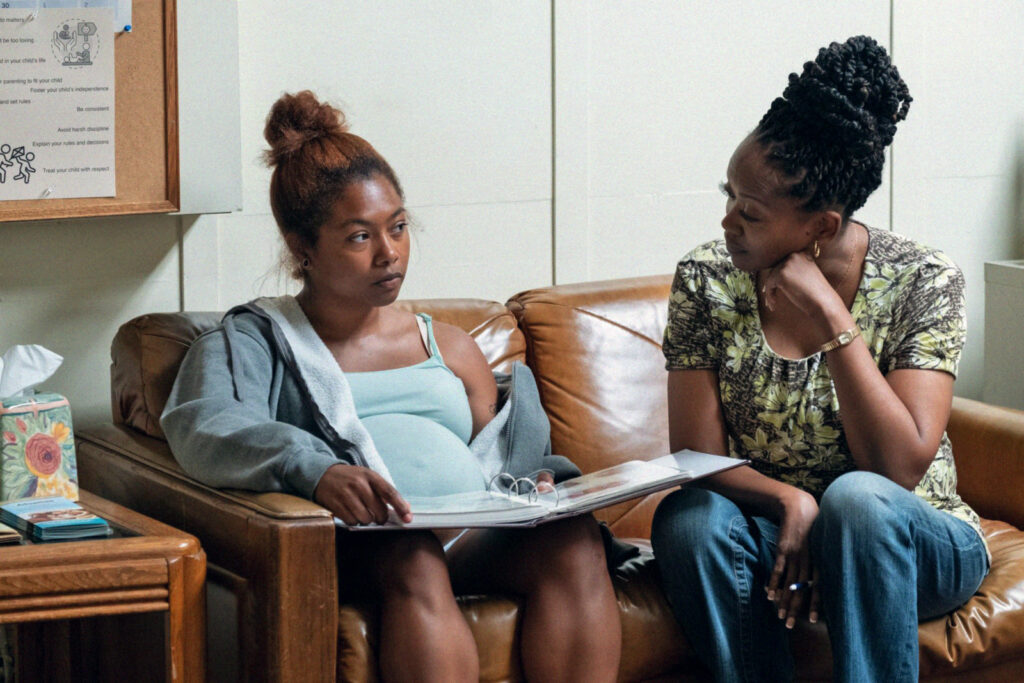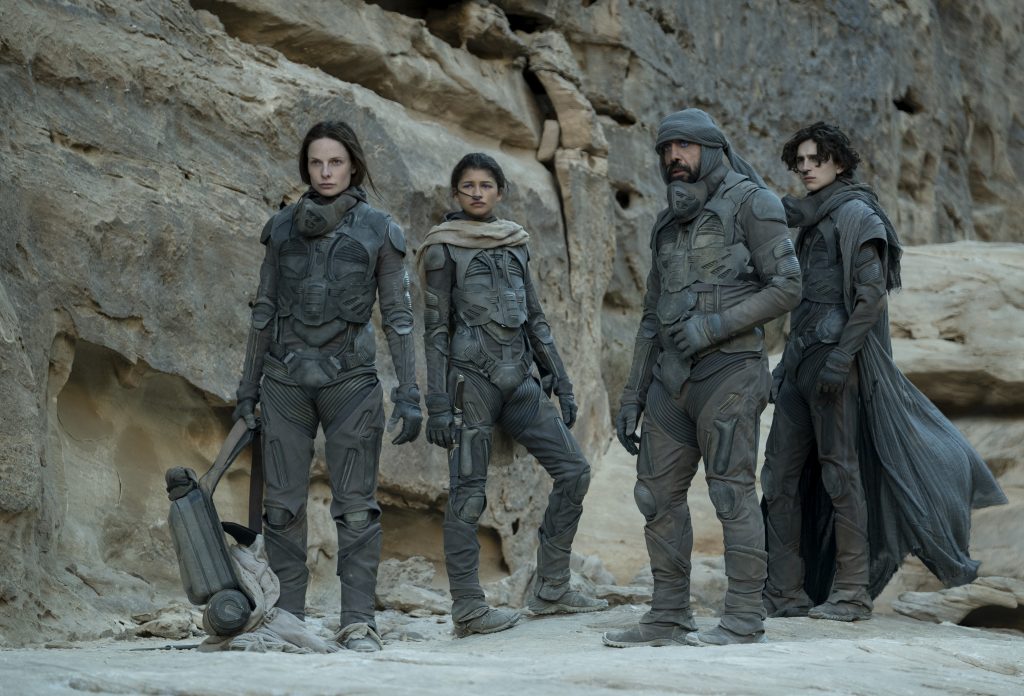July 24, 2023
by Carla Hay

Directed by Savanah Leaf
Culture Representation: Taking place primarily in the San Francisco Bay Area, the dramatic film “Earth Mama” features a predominantly African American cast of characters (with some white people and Latin people) representing the working-class and middle-class.
Culture Clash: A drug-addicted, financially broke single mother, who is pregnant and in rehab counseling, goes through various struggles, as she tries to regain custody of her two kids in foster care and has to decide what do about how her third child will be raised.
Culture Audience: “Earth Mama” will appeal primarily to people who are interested in watching good acting in an artfully made gritty film, even if the movie rehashes a lot of familiar themes about American women living in urban poverty.

“Earth Mama” has very impressive acting performances, but it doesn’t offer any new ideas. It over-uses tiresome negative stereotypes of black women as drug-addicted single mothers, while the diversity of black women is muted or ignored in this movie. “Earth Mama” had its world premiere at the 2023 Sundance Film Festival. Although the movie’s technical crafts are admirable, “Earth Mama” has the same old clichés that have been unfortunately used by ignorant people as reasons to believe the lie that most African American women are inferior, stuck in a “ghetto” rut, and doomed to fail in life.
Written and directed by Savanah Leaf, “Earth Mama” is her feature-film directorial debut and is based on Leaf’s 2020 short film “The Heart Still Hums.” Although it’s usually not necessary to point out a filmmaker’s race in a review, it should be noted that Leaf is African American. That’s really no excuse for any filmmaker to perpetuate some of the movie’s damaging portrayals that economically deprived people are a bunch of self-pitying whiners. And to be clear: There is a lot of self-pitying whining in this movie, which comes dangerously close to being offensive in how low-income African American women are portrayed as being of a similar mindset, instead of showing a more realistic variety.
In “Earth Mama” (which takes place in the San Francsico Bay Area, mostly in Oakland, California), single mother Gia (played Tia Nomore) is 24 years old, pregnant, in outpatient drug rehab, and struggling to get by on her low income. She has a part-time job as an assistant at a small photography studio in a shopping mall. The movie unfolds over the course of a few months, like chapters in Gia’s life. Some of Gia’s life before this time period is explained, while other questions that viewers might have about Gia’s past remain unanswered. In the beginning of the movie, which is told in chronological order, Gia is about eight months pregnant.
At a certain point in the movie, what is revealed is that Gia has two other children who are in foster care because of her legal problems and drug addiction. (Viewers find out later that Gia is addicted to crack cocaine and in recovery for it.) Gia’s oldest child is daughter Shayna (played by Alexis Rivas), who’s about 7 or 8 years old. Her middle child is son Trey (played by Ca’Ron Coleman), who’s about 5 or 6 years old. Fortunately, Trey and Shayna are both being taken care of in the same foster home, for now.
Gia has limited and supervised visitation rights with Shayna and Trey. Shayna mostly refuses to talk to Gia, despite Gia’s best efforts to have have a loving and trustful relationship with Shayna. Trey is more receptive to Gia’s attention. Gia wants to regain custody of Shayna and Trey, but the odds are stacked against Gia because of her troubled history and because she can’t afford to take care of these kids.
“Earth Mama” shows Gia as a doting and concerned mother when she visits Shayna and Trey. As a way to bond with these two children, Gia gives sensory rings to Shayna and Trey that match a sensory ring that Gia has. “Earth Mama” doesn’t go into details over the reasons why Gia lost custody of Shayna and Trey, but Gia is on probation and appears to be very remorseful and willing to make amends for whatever she did to cause this difficult situation.
The fathers of these children are not seen or mentioned in “Earth Mama.” Gia says more than once in the movie that she’s not really interested in dating anyone. She also seems bitter and pessimistic about ever finding a true love partner who will treat her with kindness and respect. In other words, she’s been badly hurt by the fathers of her children.
Gia’s closest companion is her best friend Trina (played by Doechii), who is also pregnant and without a love partner. Trina firmly believes that Gia should keep Gia’s unborn child and do everything legally possible to win back custody of Shayna and Trey. Trina is very outspoken with her opinion that if Gia doesn’t raise these three children herself, then Gia is being a “bad mother.”
Gia later befriends a somewhat androgynous woman in her 20s named Mel (played by Keta Price), who meets Gia when Mel helps Gia assemble a baby crib. Mel doesn’t state what her sexuality is, but the movie implies that Mel is probably sexually attracted to Gia, who treats Mel as a platonic friend. A man in his 20s named Miles (played by Dominic Fike) also comes into Gia’s life as a friend.
Gia’s case worker in government social services is Miss Carmen (played by Erika Alexander), who is empathetic about Gia’s situation but she doesn’t coddle Gia. Carmen also encourages Gia to explore her options on what to do about Gia’s unborn child. Carmen thinks the best option would be for Gia to give this unborn child up for adoption.
After initially resisting the idea, Gia meets a prospective adoptive family: a middle-aged, middle-class, married couple named Monica (played by Sharon Duncan-Brewster) and Paul (played by Bokeem Woodbine) and their daughter Amber (played by Kamaya “Kami” Jones), who’s about 15 or 16 years old. Amber has mixed-to-positive feelings about getting a younger sibling through adoption. Monica and Paul are very eager to have another child.
Monica and Paul give Gia a summary of their courtship and marriage. Paul and Monica, who began dating each other when they were college, got married and became parents to Amber when Paul and Monica were still very young. The couple decided to wait to have another child until after they were more financially stable.
Years later, when Monica and Paul felt the time was right to have a second child, Monica had difficulty conceiving. And that’s why Monica and Paul are turning to adoption to have a second child. Although they know it would be easier to adopt a child from a country with less restrictive adoption laws, Paul and Monica (who are both African American) have decided they wanted to go through the U.S. adoption system, specifically to adopt a child who is the same race as they are.
“Earth Mama” shows a series of vignettes in Gia’s life before, during and after she makes the decision of whether or not to give up her unborn child for adoption. These vignettes are very “slice of life,” including some repetitive scenes of Gia at her job, where she mainly makes sure that backdrops and props are prepared when people take studio portraits. There are also several repetitive scenarios showing how financially broke Gia is, such as scenes of her using her prepaid phone and being worried that the phone will soon run out of money.
At group rehab meetings, Gia has to be prompted to open up about her feelings and experiences. These rehab meetings show people telling their sob stories with a self-defeating “woe is me/I’m stuck and I can’t do better” attitude. Expect to hear people complaining about their bad childhoods in these meetings instead of wanting to figure out how to improve their lives.
“Earth Mama” deals with race relations as something to get out of the way in the story, because the movie is more interested in its agenda of getting audiences to feel sympathy for Gia. Race relations in “Earth Mama” are not adequately explored or depicted. In real life, people in Gia’s community and environment would talk a lot more about racism than they do in this movie.
The closest that thing that “Earth Mama” does to show any racial tension is a scene during one of the rehab meetings that Gia attends. White people are in the minority in these meetings, not because white people have less drug problems than people who aren’t white, but because these meetings happen to take place in an area where most of the people are not white. When one of these white attendees—a young woman named Alexis (played by Olivia Luccardi)—begins rambling while talking, Gia expresses some annoyance that Alexis seems to get more time to talk because Alexis is white.
Gia isn’t a very complicated person, but Nomore gives a wonderfully nuanced performance that skillfully expresses many of Gia’s emotions that Gia might not say out loud. Fortunately, “Earth Mama” doesn’t succuumb to two lazy movie/TV stereotypes of black women living in poverty: making single mother Gia always fighting with her “baby daddies,” or having Gia speak like she wouldn’t be able to pass a basic course in English grammar. Gia isn’t academically well-educated, but she can communicate well when she wants to communicate well.
Gia is not saintly—she can be rude and somewhat flaky—but the movie really goes out of its way to distract viewers from thinking about why Gia lost custody of her children. “Earth Mama” has some horror-like elements that show Gia’s nightmarish hallucinations. A frequent hallucination that Gia has shows her pulling out the umblical cord from her body. There are artfully hazy scenes of Gia wandering in a forest. And composer Kelly Lu’s dreamlike piano-based musical score complement the somewhat pretentious way that “Earth Mama” shows urban decay as a type of cinematic art project.
“Earth Mama” obviously wants to have a certain portrayal of African American womanhood. But perhaps the biggest missed opportunity of “Earth Mama” is how it doesn’t do enough to show more diversity of African American women in this environment. Not all low-income African American women see themselves as perpetual victims, like Gia does. Not all low-income African American women see their situations as too hard to overcome, like Gia does. Gia is in survival mode, but she’s also stuck in a cycle of self-pity. Gia also takes for granted that she has access to several free and helpful resources that many impoverished women (especially in Third World countries) do not have.
Alexander’s performance as Carmen is compelling but abbreviated. There are hints that social worker Carmen has a very interesting life and can relate to Gia more than Gia knows, but “Earth Mama” fails to bring more of Carmen to the movie, other than being a concerned and occasionally lecturing authority figure. Potential adopter Monica is another female character who is very underdeveloped in the movie, probably because it would ruin the “Earth Mama” narrative of poor Gia having such a hard life.
People who do not personally know a variety of black women are most likely to hail “Earth Mama” as a very insightful look into the state of black womanhood. Meanwhile, people who personally know a variety of black women—and know that most black women are not single mothers with arrest records and drug addictions—are less likely to charmed by this skewed lens of black womanhood that “Earth Mama” offers. There’s a reason why audiences of all races and backgrounds are turning away from these movies that are about “black people stuck in the ghetto”: These types of movies—which were in abundance in the 1970s, 1980s, and 1990s—seem played out in modern times, when there is so much more awareness of many real-life black people who do not live and have never lived that type of “ghetto” life.
A24 released “Earth Mama” in select U.S. cinemas on July 7, 2023. The movie will be released on digital and VOD on July 28, 2023.


